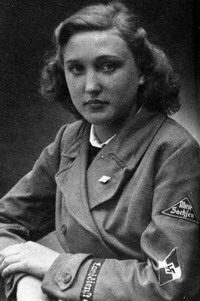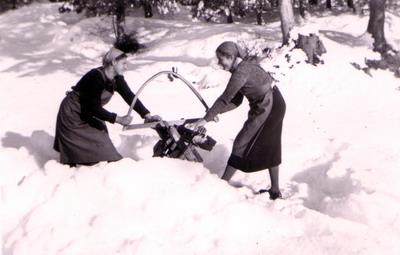BDM Osteinsatz
 In the wartime work of both the male Hitler Youth as well as the female League of German Girls, the Osteinsatz, or Eastern Action, played an important role.
In the wartime work of both the male Hitler Youth as well as the female League of German Girls, the Osteinsatz, or Eastern Action, played an important role.
The basic idea behind this duty was for the young men and women to aid and support re-settlers who had been relocated to Poland, particularly areas of western Prussia, upper Silesia, and the Wartheland. These re-settlers were Volksdeutsche, or ethnic Germans, who had previously lived in the Baltics, Bessarabia, Galicia, and eastern Poland and had now been relocated “into the Reich”.
Work within the Hitler Youth Eastern Action served two main purposes – to set up leadership and help support the ethnic German youth, and to help and support the re-settlers both in their farm work as well as in their “new” German identity.
Members of the League of German Girls participating in this work were volunteers, and many welcomed this opportunity because Eastern Action work, though almost always shorter than seven or eight months in duration, counted as a full “service year”.
Members of the BDM Eastern Action wore a special cufftitle on their uniform jacket, such as the one seen below. For more information about BDM cufftitles and other insignia, please check the “badges & insignia” section under “uniforms”.

Leadership and Support of the Youth
The Osteinsatz program’s goal for the ethnic German youth was to bring them onto the same level than German youth living inside the “old” German Reich in terms of language, education, culture, community, and job training.
Older ethnic German youths were sent to attend resettlement camps in which they spent six months in educational classes and job training. Aside from an education that focused very much on cultural and philosophical aspects, they also underwent a lot of physical fitness training and education. Job training offered at these camps mainly centered around skills that were essential to country and farm work, as well as traditional handicrafts such as masonry and carpentry.
In addition to skills necessary around the farm and as a homemaker in their family homes, ethnic German girls who attended these camps were also educated about other job opportunities that were open to them in the fields of social, educational, and medical services.
All youths also received first aid medical training on the same level than the League of German Girl’s “Unfalldienst” or the male Hitler Youth’s “Feldscher” services, so that they could serve as medics since many areas of Eastern Poland to which they had been resettled had hardly any doctors or medical centers available.
Aside from the educational aspects of the Osteinsatz, cultural work also played an important part, particularly in the field of music. In summer of 1942, a hundred and thirty music workgroups were sent to western Prussia and upper Silesia, and were joined soon thereafter by 152 music teachers who’d graduated from the League of German Girls’ musical education center at Litzmannstadt.
Because new units of the Hitler Youth and the League of German Girls were being established among the resettler youth in the East, leaders were selected during the camps and leadership courses were held as well to meet the demand for leaders to take over these new units. Since many of the experienced older leaders of the male Hitler Youth had joined the armed forces after 1939, much of this selection, training, and youth work with the male youth also rested on the shoulders of BDM leaders working with the Osteinsatz. By 1943, the male Hitler Youth began to specially train lower ranking and newer Hitler Youth leaders to take on these tasks among the male youth in the East to relieve the female staff. In addition to Hitler Youth leaders, experts from Germany such as sports teachers, also helped with this work.
Soon, a new program, “Berufsausbildungsprogramm Ost” (Job Training Program East) was introduced by the Minister of Economics, which the Hitler Youth also became intensively involved in. It was important that the laws for the protection of minors and protection of employment were also upheld in the Eastern territories, not just within the borders of the old Reich.
Not only apprenticeship workshops were built, but also homes for young people who had volunteered to come to the East for their vocational training. By the year 1943, a hundred eighty three of these homes had been built and provided living space for approximately 4,000 teenagers.
Support of the Re-Settlers
The tasks of lending support and help to the re-settler families in the East became the domain of the League of German Girls, and their national leader, ReichsreferentinDr. Jutta Ruediger, personally attended to it. This BDM-Osteinsatz became a test for the League because it partially served as an indicator of what amount of work and dedication the youth was able to bring with them when they rose to the challenge.
In the beginning, BDM leaders voluntarily gave up their holidays in order to spend six week periods helping ethnic German families who were new to the areas they’d been resettled to, to get them set up in their new homes, farms, and lives. At first this work was limited to the Warthegau, then expanded to west Prussia and upper Silesia, and after 1943 to Eastern Prussia and lower Silesia as well.
From its first year (1940) onward, the number of BDM leaders participating in the BDM-Osteinsatz rose consistently: from a mere 1,400 in 1940 to 12,901 by 1943.
In order to get its members to volunteer for this important work for a period of time longer than only six weeks, the League’s leadership decided that a half year of work in the Osteinsatz would count as a whole year of the mandatory “service year” girls had to absolve. It worked. By 1942, 809 girls absolved their service year obligation this way.
BDM camps were erected near the villages in which the re-settlers lived, usually one camp for three or four local villages. This is where BDM girls lived during their work in the East. Each camp had several groups of girls, and each group of about ten to fifteen girls was supervised by a Ring- or Bannmaedelfuehrerin. Later, full-time camp leaders were appointed in order to get things working more smoothly.

Because their work required them to handle a lot of responsibility, only BDM leaders were allowed to volunteer for the Osteinsatz at first. After they had gained enough experience in their positions they could be paired up with a younger member from the League’s ranks.
The girls helped ethnic German families with heavy work on the farmland, but also helped set up the homes, watched the children, and celebrated seasonal holidays with them, for example, Easter or the Erntedankfest (harvest festival). During Christmastime, leaders had to work especially hard to set up a traditional German Christmas, and to make sure each of the re-settlers’ children received a present.
“Young Germany” magazine reports in an article from March 1944, “BDM Leaders are always pointing out how, even though they had a lot to worry about and went through much hard work, it was their most beautiful Christmas celebration ever since they were able to bring so much joy to others.”
Among the League’s work in the Osteinsatz, one of the most important aspects was setting up schools and kindergartens for the re-settlers’ children. At first, this was often done very preliminary and under difficult circumstances because the first BDM leaders working in the East had no training or even specific knowledge on how to run a school or kindergarten or what and how to teach.
From these small first steps evolved training for the new positions of BDM Schulhelferin (BDM teaching assistant) and BDM Kindergartenhelferin (BDM preschool teaching assistant). The girls, both BDM members in the Osteinsatz and ethnic German youths, who already had some practical experience and were interested could attend short teacher training courses back in the Reich and then return in the East to work as school or kindergarten teachers. Girls were not chosen to attend teaching courses based on their previous education, but rather on the basis of their aptitude. The majority had only graduated from a Volksschule (elementary school) in the eight grade with no specific diploma, 25% of them had secondary school diplomas, and only 2% had high school diplomas.

Starting in 1942, the National Youth Leadership and the Ministry of Education began setting up the teacher courses which lasted about four months. By May 1942, the first Schulhelferin courses were held at the former teachers’ college in Elbing, West Prussia; another training center was founded in Posen during the same year. The course ended with a two-week BDM leadership course.
BDM Schulhelferinnen with one or two years of practical work were also able to apply for a nine-month teaching course to become professional Volksschul-teachers. Nearly all of the girls who applied for this course had wanted to become teachers but had been unable to do so because they could not afford the schooling.
Because of the BDM’s work, the Wartheland region had 200 new schools by 1942, which gave as many as 8,000 children access to education.
When leaders returned from the Osteinsatz they told others back home about their experiences and tasks. After hearing about what was being accomplished in the East, and with the help of local BDM and Hitler Youth groups, towns in the old Reich soon “adopted” towns in the new areas and donated items that were much needed in the new areas, such as school supplies, books, radios, farm implements, and sports equipment. And, of course, more BDM-leaders volunteered to do their duty in the East as well. Especially girls from farming communities in the old Reich who had experience and training in farm work and were also BDM leaders often volunteered to help the resettled families with their knowledge and experience.
All volunteers had to bring a lot of enthusiasm and idealism because the work in the newly settled areas required a lot of physical and mental strength and endurance. Many villages did not have any doctors or nurses, midwives, or even priests. So the tasks of caring for the sick, helping with birth, and burying the dead often had to be taken on by BDM leaders. They frequently found themselves facing entirely new and unusual situations they had to master.
Dr. Hildegard Friese wrote about this in her book, “Unsere Settler im Kreis Welun“: “The BDM Osteinsatz manifests itself as one of the happiest forms of the many ways of support coming from Germany – never mind the experiences each girl is going to take away from this and pass on to others – because it helps the entire re-settled family, it sends city youth to young and old out in the country, and pushes “duty” into the background and instead teaches giving and taking in all areas of life.”


